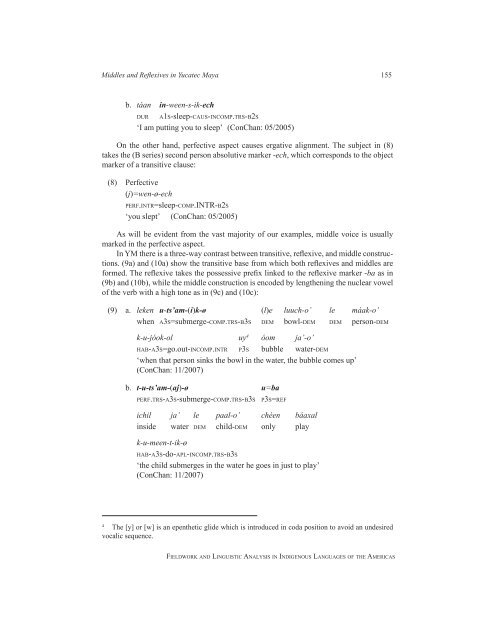Fieldwork and Linguistic Analysis in Indigenous ... - ScholarSpace
Fieldwork and Linguistic Analysis in Indigenous ... - ScholarSpace
Fieldwork and Linguistic Analysis in Indigenous ... - ScholarSpace
Create successful ePaper yourself
Turn your PDF publications into a flip-book with our unique Google optimized e-Paper software.
Middles <strong>and</strong> Reflexives <strong>in</strong> Yucatec Maya 155<br />
b. táan <strong>in</strong>-ween-s-ik-ech<br />
dur a1s-sleep-caus-<strong>in</strong>comP.trs-b2s<br />
‘I am putt<strong>in</strong>g you to sleep’ (ConChan: 05/2005)<br />
On the other h<strong>and</strong>, perfective aspect causes ergative alignment. The subject <strong>in</strong> (8)<br />
takes the (B series) second person absolutive marker -ech, which corresponds to the object<br />
marker of a transitive clause:<br />
(8) Perfective<br />
(j)=wen-ø-ech<br />
Perf.<strong>in</strong>tr=sleep-comP.<strong>in</strong>tr-b2s<br />
‘you slept’ (ConChan: 05/2005)<br />
As will be evident from the vast majority of our examples, middle voice is usually<br />
marked <strong>in</strong> the perfective aspect.<br />
In YM there is a three-way contrast between transitive, reflexive, <strong>and</strong> middle constructions.<br />
(9a) <strong>and</strong> (10a) show the transitive base from which both reflexives <strong>and</strong> middles are<br />
formed. The reflexive takes the possessive prefix l<strong>in</strong>ked to the reflexive marker -ba as <strong>in</strong><br />
(9b) <strong>and</strong> (10b), while the middle construction is encoded by lengthen<strong>in</strong>g the nuclear vowel<br />
of the verb with a high tone as <strong>in</strong> (9c) <strong>and</strong> (10c):<br />
(9) a. leken u-ts’am-(i)k-ø (l)e luuch-o’ le máak-o’<br />
when a3s=submerge-comP.trs-b3s dem bowl-dem dem person-dem<br />
k-u-jóok-ol uy 4 óom ja’-o’<br />
hab-a3s=go.out-<strong>in</strong>comP.<strong>in</strong>tr P3s bubble water-dem<br />
‘when that person s<strong>in</strong>ks the bowl <strong>in</strong> the water, the bubble comes up’<br />
(ConChan: 11/2007)<br />
b. t-u-ts’am-(aj)-ø u=ba<br />
Perf.trs-a3s-submerge-comP.trs-b3s P3s=ref<br />
ichil ja’ le paal-o’ chéen báaxal<br />
<strong>in</strong>side water dem child-dem only play<br />
k-u-meen-t-ik-ø<br />
hab-a3s-do-aPl-<strong>in</strong>comP.trs-b3s<br />
‘the child submerges <strong>in</strong> the water he goes <strong>in</strong> just to play’<br />
(ConChan: 11/2007)<br />
4 The [y] or [w] is an epenthetic glide which is <strong>in</strong>troduced <strong>in</strong> coda position to avoid an undesired<br />
vocalic sequence.<br />
fieldwork <strong>and</strong> l<strong>in</strong>guistic analysis <strong>in</strong> <strong>in</strong>digenous languages of the americas

















